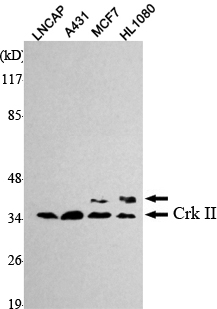Crk II Monoclonal Antibody
- Catalog No.:YM1024
- Applications:WB
- Reactivity:Human;Mouse;Dog;Rabbit
- Target:
- Crk II
- Fields:
- >>MAPK signaling pathway;>>ErbB signaling pathway;>>Rap1 signaling pathway;>>Chemokine signaling pathway;>>Focal adhesion;>>Fc gamma R-mediated phagocytosis;>>Neurotrophin signaling pathway;>>Regulation of actin cytoskeleton;>>Insulin signaling pathway;>>Growth hormone synthesis, secretion and action;>>Bacterial invasion of epithelial cells;>>Shigellosis;>>Yersinia infection;>>Human cytomegalovirus infection;>>Human immunodeficiency virus 1 infection;>>Pathways in cancer;>>MicroRNAs in cancer;>>Renal cell carcinoma;>>Chronic myeloid leukemia
- Gene Name:
- CRK
- Protein Name:
- Adapter molecule crk
- Human Gene Id:
- 1398
- Human Swiss Prot No:
- P46108
- Mouse Gene Id:
- 12928
- Mouse Swiss Prot No:
- Q64010
- Rat Swiss Prot No:
- Q63768
- Immunogen:
- Purified recombinant human Crk II protein fragments expressed in E.coli.
- Specificity:
- Crk II Monoclonal Antibody detects endogenous levels of Crk II protein.
- Formulation:
- Liquid in PBS containing 50% glycerol, 0.5% BSA and 0.02% sodium azide.
- Source:
- Monoclonal, Mouse
- Dilution:
- WB 1:1000 - 1:2000. Not yet tested in other applications.
- Purification:
- Affinity purification
- Concentration:
- 1 mg/ml
- Storage Stability:
- -15°C to -25°C/1 year(Do not lower than -25°C)
- Other Name:
- CRK;Adapter molecule crk;Proto-oncogene c-Crk;p38
- Molecular Weight(Da):
- 34kD
- Background:
- This gene encodes a member of an adapter protein family that binds to several tyrosine-phosphorylated proteins. The product of this gene has several SH2 and SH3 domains (src-homology domains) and is involved in several signaling pathways, recruiting cytoplasmic proteins in the vicinity of tyrosine kinase through SH2-phosphotyrosine interaction. The N-terminal SH2 domain of this protein functions as a positive regulator of transformation whereas the C-terminal SH3 domain functions as a negative regulator of transformation. Two alternative transcripts encoding different isoforms with distinct biological activity have been described. [provided by RefSeq, Jul 2008],
- Function:
- domain:The C-terminal SH3 domain function as a negative modulator for transformation and the N-terminal SH3 domain appears to function as a positive regulator for transformation.,domain:The SH2 domain mediates interaction with SHB.,function:The Crk-I and Crk-II forms differ in their biological activities. Crk-II has less transforming activity than Crk-I. Crk-II mediates attachment-induced MAPK8 activation, membrane ruffling and cell motility in a Rac-dependent manner. Involved in phagocytosis of apoptotic cells and cell motility via its interaction with DOCK1 and DOCK4.,PTM:Phosphorylated on Tyr-221 upon cell adhesion. Results in the negative regulation of the association with SH2- and SH3-binding partners, possibly by the formation of an intramolecular interaction of phosphorylated Tyr-221 with the SH2 domain. This leads finally to the down-regulation of the Crk signaling pathway.,PTM:P
- Subcellular Location:
- Cytoplasm . Cell membrane . Translocated to the plasma membrane upon cell adhesion. .
- Expression:
- Embryonic lung,Epithelium,Eye,Lung,Placenta,
- June 19-2018
- WESTERN IMMUNOBLOTTING PROTOCOL
- June 19-2018
- IMMUNOHISTOCHEMISTRY-PARAFFIN PROTOCOL
- June 19-2018
- IMMUNOFLUORESCENCE PROTOCOL
- September 08-2020
- FLOW-CYTOMEYRT-PROTOCOL
- May 20-2022
- Cell-Based ELISA│解您多样本WB检测之困扰
- July 13-2018
- CELL-BASED-ELISA-PROTOCOL-FOR-ACETYL-PROTEIN
- July 13-2018
- CELL-BASED-ELISA-PROTOCOL-FOR-PHOSPHO-PROTEIN
- July 13-2018
- Antibody-FAQs
- Products Images

- Western Blot analysis using Crk II Monoclonal Antibody against LNCAP, A431, MCF7, HL1080 cell lysate.



